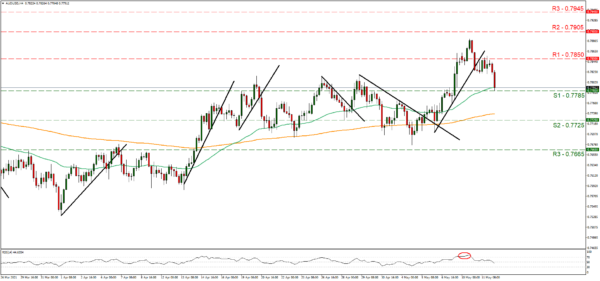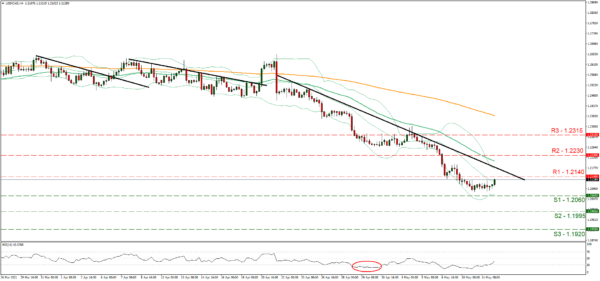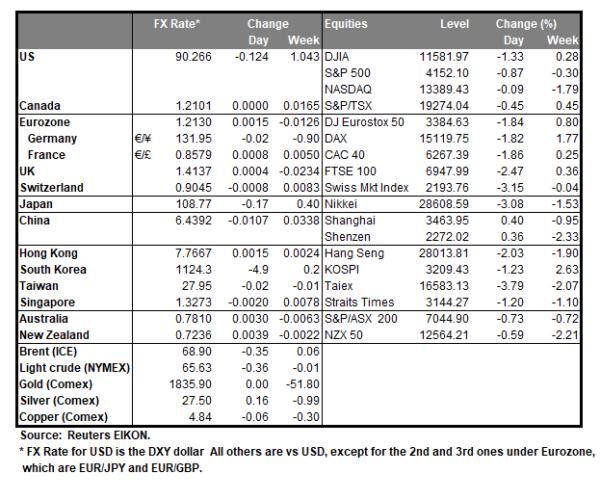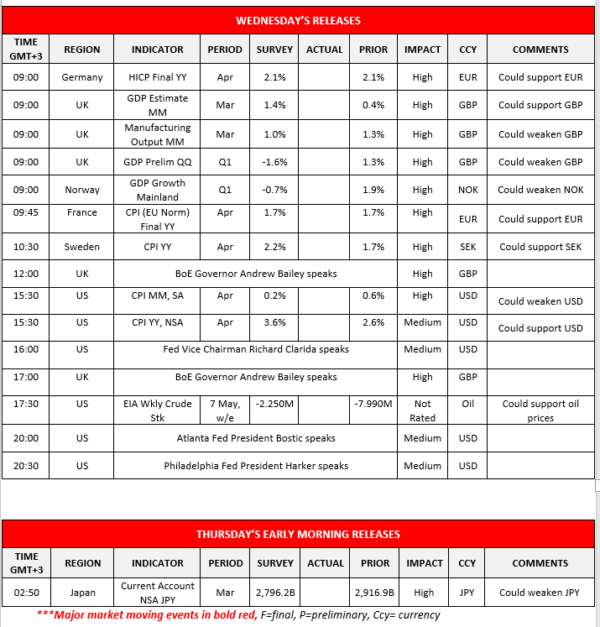USD remained at rather low levels yesterday yet stabilized and even had some small gains against its counterparts yesterday. The market is still focused on the Fed’s intentions and whether it plans to tighten its monetary policy through its asset purchases program mainly and April’s US inflation rates which are due out later today are in the epicenter of the market’s attention. For the time being the Fed seems to stick to its ultra loose monetary policy and its characteristic that Fed Governor Brainard stated yesterday that weak labour data released last week for April, show that the recovery has a long way to run. Yet should inflation rates accelerate more than forecasted, especially on a year on year level, we may see the USD getting some support as the pressure on the Fed could increase. Also note that things weren’t so rosy in the US equities markets, given that Dow Jones tumbled, while in the FX market the effect seems to be bigger on commodity currencies such as AUD.
AUD/USD dropped from the highs of the 0.7850 (R1) resistance line and aimed for the 0.7785 (S1) support level, which was tested during today’s Asian session. We tend to maintain a bias for a sideways motion currently between the prementioned levels, yet bears seem to have a slight advantage, given that the RSI indicator below our 4-hour chart has a downward slope. Should the bears actually maintain control over the pair we may see AUD/USD breaking the 0.7785 (S1) support line and aim for the 0.7725 (S2) support level. Should the bulls take over, we may see the pair aiming for the 0.7850 (R1) resistance line and aim for the 0.7950 (R2) level.
CAD steadies near 3 ½ year levels
The Canadian dollar steadied against its U.S. counterpart on Tuesday, holding near its strongest level in 3 ½ years as higher commodity prices added to investors’ worries about the outlook for inflation. Given that Canada is major commodities producing economy, including oil, and that WTI prices settled slightly higher, boosted by supply worries created by the cyberattack on one of the largest US pipelines, we may see CAD getting some support should oil prices rise further. Also please note that on second base the confidence as expressed by BoC’s hawkish tilted tone in its last meeting, also supports the CAD and traders keep an eye out for BoC governor Macklem’s speech, which is scheduled for tomorrow. Overall and given the lack of financial releases from Canada we expect fundamentals to take the lead in guiding the Loonie in the next days, while EIA’s crude oil inventories figure due out today could have an indirect effect on the CAD today.
USD/CAD stabilised near its 3 ½ year lows and there seem to be also some bullish tendencies as the pair aimed for the 1.2140 (R1) resistance line, during the Asian session today. For the time being we maintain a bias for a sideways motion, yet the bulls may take the initiative, given also the upward slope of the RSI indicator below our 4-hour chart. Should the upward motion intensify, we may see the pair breaking the 1.2140 (R1) line and aim for the 1.2230 (R2) level. Should a selling interest be displayed by the market we may see USD/CAD reversing course, breaking the 1.2060 (S1) line and aim for the 1.1995 (S2) level.
Other economic highlights today and the following Asian session:
Today during the European session, we highlight the release of Germany’s and France’s final HICP rates for April, UK’s GDP rates for March and Q1 as well as the UK’s manufacturing output growth rate for March, while from Norway we get the GDP rates for Q1 and from Sweden the inflation rates for April. In the American session, we highlight the US CPI rates for April while oil traders maybe more interested in the release of the EIA weekly crude oil inventories figure. Please note that BoE Governor Andrew Bailey and Fed Vice Chair Clarida are scheduled to speak. During Thursday’s Asian session, we get Japan’s current account balance for March.
Support: 0.7785 (S1), 0.7725 (S2), 0.7665 (S3)
Resistance: 0.7850 (R1), 0.7905 (R2), 0.7945 (R3)
Support: 1.2060 (S1), 1.1995 (S2), 1.1920 (S3)
Resistance: 1.2140 (R1), 1.2230 (R2), 1.2315 (R3)


















